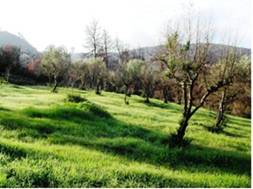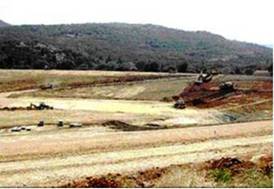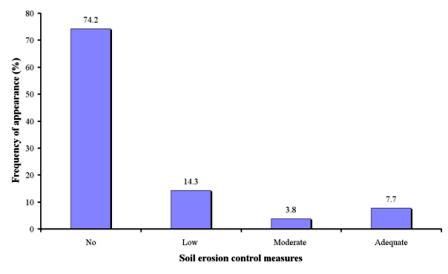Soil erosion control measures
Soil erosion control measures includes actions undertaken to reduce soil erosion caused by various factors such as surface water runoff, tillage operations, wind blowing, etc. Soil erosion control measures may include: conservation tillage, contour farming, stabilization structures, vegetated waterways, strip cropping, enhancement of understory growing vegetation, adequate plant cover, terracing, small water reservoirs, etc. Conservation tillage is a land management practice which can significantly reduces rill and interill erosion in hilly areas cultivated with annual crops. The incorporation of plant residues into the soil after harvesting increases soil organic matter content and improve soil aggregate stability.
Contour farming is considered a very effective practice for reducing soil erosion, but in many cases farmers faces security problems when slope gradient is greater than 12%. Following the contour farming, each furrow acts as a reservoir to receive and retain runoff water. However this type of ploughing can led to accelerated soil erosion and deposition in the lowland. Following the contour farming, each furrow acts as a reservoir to receive and retain the runoff water. On long length slopes and under heavy and prolonged rainfall events, contoured rows can cause considerable rilling or gulling.
Stabilization structures protect soil erosion in channels where water is concentrated. Such structures reduce runoff water velocity to non-erosive rates. Such structures can be are permanent consisting of reinforced concrete or monolithic reinforced concrete such as drop spillways, drop inlets, as well as temporary structures made of rocks, logs, brush, woven wire and other nondurable materials to dissipate the energy of falling water (Fig. 73).
Enhancement of understory annual vegetation is an appropriate land management for reducing soil erosion in hilly areas cultivated with perennial crops such as olives, vines, almonds, etc (Fig 73). Many studies have been shown that such vegetation cover reduces soil erosion to minimum values. The only dispute for this management practice is the adsorption by this vegetation of an amount of soil water stored in the upper soil layers. This soil erosion control measure can be combining with vegetated waterways in which soil erosion is expected to be limited.
Terracing is an alternative management practice for water conservation and erosion control. Terracing decreases the slope length and reduces the damage by surface water runoff Fig. 74). It is actually a very old practice having been used for centuries in many places of the world.


Fig 73. Temporal stabilization structure for reducing water runoff in channel to non-erosive rates (left) and enhancement of understory vegetation for reducing soil erosion after a fire in a olive grove (right)
Strip cropping is a practice in which hilly areas are not cultivated uniformly with the same crop. There are alternative strips with various crops growing in different period. Therefore, if runoff occurs form one field which is not well vegetated then this water is trapped in next field which is well vegetated. Furthermore, Small water reservoirs are constructed at farm level or in collaboration of nearby farmers. Water is temporarily stored into the reservoir reducing down slope water runoff (Fig 74).


Fig. 74. Small terraces vegetated to reduce accelerated erosion (left) and small water reservoir for temporal storage of water runoff
The efficacy of the existing soil erosion control measures have been defined in this project based on a self explanatory estimation as following: : (a) no actions undertaken, (b) low, incomplete protection, less than 25% of the area is protected; (c) moderate, partial protection, 25-75% of the area is protected; (d) adequate, complete protection, >75 of the area is protected.
As Table 10 shows, data for this indicator have been collected in 1305 field sites, corresponding to 16 study sites. The analysis of the data shows that in the majority of the study field sites (74.2% of the total sites) no soil erosion measures have been undertaken. Of course such land management practices are very negative in combating land degradation in areas sensitive to desertification. Such conditions have been defined in all study sites of Novij Saratov-Russia, Eskisehir-Turkey, Rendina Basin Basilicata-Italy, and Loess Plateau-China, and in some cases in the study sites of Boteti Area-Botswana, Djanybek-Russia, Secano Interior-Chile, Santiago Island-Cape Verde, Mamora Sehoul-Morocco, Zeuss Koutine-Tunisia, Mação- Portugal, Guadalentin Basin Murcia-Spain, Cointzio Catchment-Mexico, Gois-Portugal, and Crete-Greece. Low soil erosion control measures have been identified in 14.3% of the study field sites, corresponding to the study sites of Djanybek-Russia, Secano Interior-Chile, Santiago Island-Cape Verde, Mamora Sehoul-Morocco, Guadalentin Basin Murcia-Spain, and Konya Karapinar plain-Turkey, Mação- Portugal, Cointzio Catchment-Mexico, Gois-Portugal, and Crete-Greece. Adequate measures of soil erosion control have been defined in 7.7% of the study field sites, corresponding to the study sites of Boteti Area-Botswana, Secano Interior-Chile, Santiago Island-Cape Verde, Zeuss Koutine-Tunisia, and Crete-Greece. Finally, moderate measures for soil erosion control have been found only in 3.8% of the study field sites, corresponding in few cases in the study sites of Secano Interior-Chile, Santiago Island-Cape Verde, Mamora Sehoul-Morocco, Zeuss Koutine-Tunisia, and Crete-Greece.

Fig. 75. Distribution of soil erosion control measures defined in the study field sites